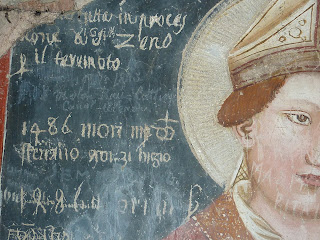All over Italy, we are seeing the records of the middle ages and the renaissance in fresco : that difficult mode of painting that involved drawing on the wall in sepia chalk, then marking off just enough of the drawing that you could paint in a day, mixing fresh plaster, putting it over the drawing, and then remembering the drawing while you put your paints onto the wet plaster. When it dried, it was there for as long as the wall lasted.
Mostly, these frescoes are in churches (see the previous post). But some aren't. Since we have been going to a lot of the courts of the Renaissance princes, many of the frescoes we've seen have been part of the palaces these dukes built or renovated out of old fortresses.
 In room after room -- banquet halls, ducal reception rooms, private quarters (as private as a 16th century duke could be) -- the ceilings and the upper parts of walls are filled with frescoes. These bring into these often vast rooms a vivid sense of color and light. And a kind of human record: the rooms are often bare of furniture -- it's been sold off or stolen long ago -- but here, way above our heads, are strange reflections of the life these princes thought they wanted to lead.
In room after room -- banquet halls, ducal reception rooms, private quarters (as private as a 16th century duke could be) -- the ceilings and the upper parts of walls are filled with frescoes. These bring into these often vast rooms a vivid sense of color and light. And a kind of human record: the rooms are often bare of furniture -- it's been sold off or stolen long ago -- but here, way above our heads, are strange reflections of the life these princes thought they wanted to lead.Myths dominate in these palaces: the life of the gods, leisurely and naked.
 Sometimes we actually see the owners of the places themselves, fixed in this plaster. (This is the Gonzaga family, who ruled Mantua).
Sometimes we actually see the owners of the places themselves, fixed in this plaster. (This is the Gonzaga family, who ruled Mantua).Whatever is on these walls pretty much stays there. Maybe the water drips in from the roof and ruins it, but otherwise it's part of the decor. What happens with a new owner?
Sometimes when tastes change, one fresco is plastered over, the new on top of the old, like this fresco in a church that changed its mind about what people needed to see.
In times when they actually believed in these images, only one image would have shown at one time. But we in our historical, archaeological age -- having no particular beliefs -- pry out the sequence of layers and show as much of the interweaving of periods as we can.
 We saw in one set of frescoes, handy at shoulder height and a little removed from the eyes of the sacristan, vistors' names carved in to the plaster -- some from the 20th century, some (here) from the 15th! The fresco stays on the wall, mutilated or not.
We saw in one set of frescoes, handy at shoulder height and a little removed from the eyes of the sacristan, vistors' names carved in to the plaster -- some from the 20th century, some (here) from the 15th! The fresco stays on the wall, mutilated or not.In the museums in Italy, you see an incredible number of painted canvases, oils of saints and crucifixions and martyrdoms, that have been lifted off the walls of the churches they were painted for. They end up on these strange walls -- strange, because museums are so out of context for what these paintings meant in the first place.
Wonderfully, you can't do that with frescoes, or only with great difficulty. Where they are is where they were meant to be, whatever happens to those spaces.


2 comments:
I'm enjoying your posts so much, Nick. I look forward to more.
Thanks. I am enjoying writing them! We're in Venice now for the rest of the time; a little less on the move.
Post a Comment